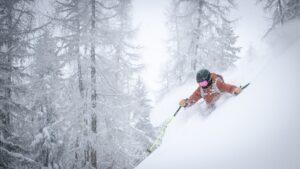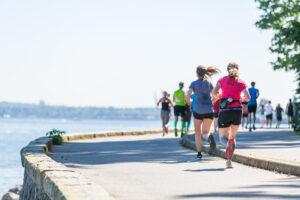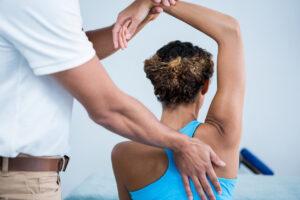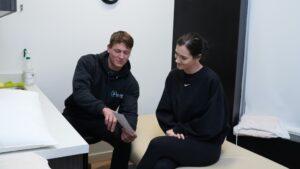As winter approaches, most of us British Columbians can’t wait to hit the slopes for ski season. While skiing is an exhilarating, refreshing, and top-tier winter sport, it can also be dangerous if you’re not properly prepared. Take it from your local physiotherapists—it’s essential to prioritize your safety and well-being to make sure you spend less time in our office and more time on the mountains!
Our ski team experts (sports physiotherapists) have decided to layout some fundamental exercises for skiing to prepare your body for a full day on the slopes. Let’s keep you injury free this ski season.
Understand Your Body’s Limitations
Before we delve into our ski exercises, it’s crucial to understand your body’s limitations and prepare accordingly. Proper warm-up and stretching are vital components of injury prevention. Start your day with a dynamic warm-up and pay attention to your body’s signals throughout the day—take breaks when needed to avoid fatigue-related injuries!
5 Exercises for Skiing Preparation
Strengthen Your Core
A strong core is the foundation for stability and balance, two critical elements for successful skiing. The plank exercise is an excellent way to engage your core muscles and build the strength necessary to navigate the slopes with confidence
1. Plank position:
- Begin by lying face down on a mat, supporting your upper body with your forearms
- Lift your body off the ground, forming a straight line from your head to your heels.
- Engage your core muscles by pulling your belly button toward your spine.
- Hold the position for 30 seconds to a minute, gradually increasing the duration as your strength improves
- Repeat for 2-3 sets.
A strong core not only enhances your skiing performance but also provides stability, reducing the risk of falls and injuries
Improve Lower Body Strength
Skiing places significant demands on your lower body, such as the quads, glute, hamstring, hip flexors, and knee joint. Leg strength can enhance your control and stability while skiing, minimizing the risk of injuries
2. Bodyweight squats:
- Stand with your feet shoulder-width apart.
- Lower your body by bending your knees and pushing your hips back, as if sitting into an imaginary chair
- Keep your chest up and back straight, ensuring your knees do not extend beyond your toes
- Lower yourself until your thighs are parallel to the ground.
- Push through your heels to return to the starting position.
- Perform 2-3 sets of 12-15 repetitions.
Bodyweight squats are an effective way to build lower body strength without the need for specialized equipment. As you progress, you can incorporate variations like goblet squats or a squat jump to add cardiovascular fitness to your routine.
Enhance Balance and Coordination
Skiing requires a high level of balance and coordination, especially when navigating varied terrain. Single-leg exercises can improve these aspects while also targeting the stabilizing muscles around your ankles and knees
3. Single-Leg Balance
- Stand on one leg, lifting the opposite foot off the ground.
- Maintain a slight bend in the supporting knee and engage your core for stability.
- Hold the position for 30 seconds, gradually increasing the duration over time.
- Switch legs and repeat.
- Perform 2-3 sets on each leg.
This exercise not only improves balance but also mimics the single-leg stance often required in skiing, preparing your muscles for the challenges of the slopes
Improve Flexibility
Flexible muscles are less prone to strains and injuries, making flexibility training a crucial component of your skiing preparation.
4. Leg Swings
- Stand next to a support, like a railing or wall, for balance.
- Swing one leg forward and backward in a controlled manner.
- Repeat for 10-15 swings and then switch to the other leg.
- Next, swing your leg from side to side, crossing the midline of your body.
- Perform 10-15 swings in each direction for both legs.
- This exercise helps increase the range of motion in your hips and prepares your muscles for the dynamic movements involved in skiing.
Leg swings are a dynamic stretching exercise that targets the muscles in your hips, thighs, and lower back.
Enhance Proprioception
Proprioception, or the awareness of your body’s position in space, is crucial for navigating the uneven terrain of ski slopes.
5. Bosu Ball Squats
- Place a Bosu ball (flat side down) on the ground.
- Stand on the Bosu ball with your feet shoulder-width apart.
- Lower your body into a squat position, keeping your knees in line with your toes.
- Ensure your core is engaged for balance.
- Rise back up to the starting position.
- Perform 2-3 sets of 12-15 repetitions.
The Bosu ball adds an element of instability, forcing your muscles to work harder to maintain balance. Bosu ball squats challenge your proprioception while also targeting your lower body muscles. This exercise translates well to the dynamic and unpredictable nature of skiing terrain.
Schedule a Tune-Up at Synergy Rehab
Incorporating these exercises into your pre-skiing routine can significantly contribute to injury prevention and enhance your overall skiing experience. Remember to listen to your body, stay hydrated, and practice good skiing etiquette on the slopes. If you’re new to skiing or have any pre-existing medical conditions, consult with our physiotherapists before embarking on your winter adventures. With the right preparation and exercises, you can enjoy the thrill of skiing while keeping your body safe and injury-free!









